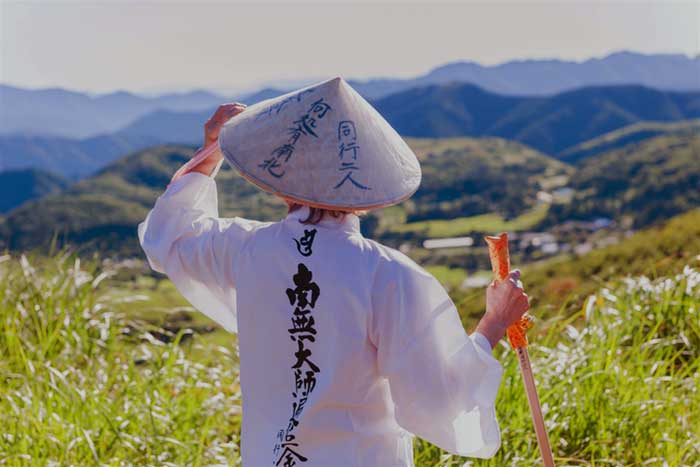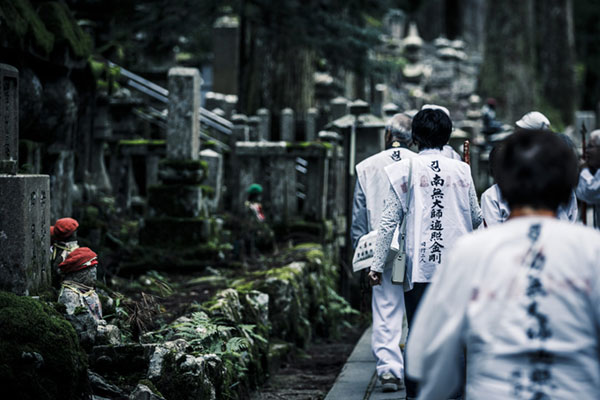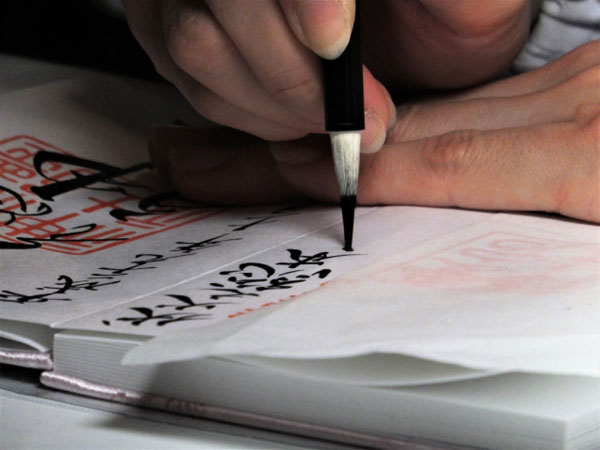ABOUT OHENRO
What’s “OHENRO”?

“Ohenro” refers to the pilgrimage around the Shikoku region in Japan that has been passed down since ancient times.
Around the year 800 AD, Kukai, known as “Kobo Daishi,” who spread Buddhism in Japan, embarked on a grand pilgrimage to visit the 88 temples associated with his teachings, creating an unparalleled journey of temple pilgrimage in the world.
While various religions around the world have their own sacred pilgrimages, such as in Christianity, Judaism, and Islam, the pilgrimage tradition in Japan is somewhat unique.
Although the Camino de Santiago also involves walking a long distance of approximately 800 kilometers, the Ohenro pilgrimage is known to be a challenging journey spanning approximately 1400 kilometers and taking over 40 days to complete.
※Kukai(Kobo Daishi) is a revered Buddhist monk who played a significant role in spreading Esoteric Buddhism (Shingon) in Japan. He established a comprehensive Buddhist university accessible to the general public, demonstrated artistic talents, and made contributions in various fields while promoting the teachings of Shingon Buddhism.
Click here to find out more↓↓
https://88shikokuhenro.jp/en/
What happens when you do the pilgrimage?

So, what are the benefits of undertaking the pilgrimage?
There are various legends and folklore surrounding this, but the commonly mentioned ones are:
- Wishes are fulfilled.
- Afflictions are alleviated, and blessings are bestowed.
- The opportunity to encounter Kukai (Kobo Daishi).
Wishes are fulfilled
The purpose of the pilgrimage varies, including tourism, spiritual practice, making wishes, and expressing devotion. It is believed that by visiting all 88 temples and completing the pilgrimage with heartfelt aspirations, one’s wishes can come true.
As examples, there are stories like the following:
“A person who had worsened to the point of being unable to walk due to rheumatoid arthritis gradually improved and recovered by walking little by little during the pilgrimage.”
“Feeling frustrated with life due to difficulties in work and love life, but through the pilgrimage, they found liberation from their unfulfilled suffering and experienced a positive transformation in life.”
When hearing such stories, one may feel inclined to believe in miracles and embark on the pilgrimage. However, it is important to note that deities may not grant every wish.
- I want to extend my lifespan.
- I want to become wealthy.
- I want a romantic partner.
- I want to embark on a journey of self-discovery.
- I want to repent for my sins.
These personal issues, as mentioned above, cannot be resolved by relying on others. They must be achieved through one’s own efforts and endeavors.
Afflictions are alleviated, and blessings are bestowed.
Embarking on the pilgrimage brings about a change in one’s heart. It is a journey where individuals confront themselves and experience inner growth.
As one’s character improves, anxieties and stress diminish, and not only does work go well, but they may also be blessed with a wonderful romantic partner.
“Feeling somewhat unsatisfied…desiring things that are yet to be obtained…”
Such desires can lead to suffering.
By walking the long path with a clear mind, one’s thoughts become clearer, allowing them to understand what truly matters.
The opportunity to encounter Kukai (Kobo Daishi).
It may sound skeptical, but there is a theory that one can encounter Kukai (Kobo Daishi) during the pilgrimage.
This legend suggests that when one undertakes the pilgrimage in reverse order, they may have an encounter with Kukai (Kobo Daishi), who performed ascetic practices while circling the temples in the regular order.
During my own pilgrimage experience, while camping in the mountains, I once heard the breath of a wild animal right beside my tent (whether it was a bear or a wild boar, I couldn’t tell).
Determined not to let it go unnoticed, I prepared myself, but within a few seconds, the animal had disappeared.
I believe that it was Kukai (Kobo Daishi) who was on the pilgrimage that came to my aid.
What is the meaning of Goshuin?

In Japan, collecting Goshuin (temple/shrine seals) has become popular, but the Goshuin obtained during the pilgrimage is different.
※Strictly speaking, it is called “Nokyo,(sutra)” not Goshuin.
Goshuin is a “mark” received from each temple where the priests read sutras to the main deity and Kukai (Kobo Daishi), forming a spiritual connection.
These Goshuin seals are considered as “passports to heaven” or “protective talismans after death,” and it is said to be beneficial to place them inside a coffin.
For the Shikoku pilgrimage, the Goshuin seals are scattered and laid out inside the coffin before cremation.
In other words, it is different from collecting stamps like passports during international travel or visiting tourist attractions.
Reaction of foreigners
Philippe have been to SHIKOKU PILGRIMAGE, and he told us his story of a multi-site pilgrimage of 88 temples✨It was so amazing! What a wonderful experience of Japan! #sakurahostel #sakuracafe #asakusa #shikoku #pilgrimage pic.twitter.com/hFBVPSsPD6
— SakuraHostelAsakusa (@asakusa_hostel) February 24, 2020
I chant the hannya shingyou (heart sutra) when my mind’s spinning. It takes me back to the Shikoku Pilgrimage, and it brings the peace from that, and a piece of that, back to me. I am so grateful.https://t.co/aMsk6LXZVZ#HeartSutra#般若心経#ShikokuPilgrimage#四国八十八ヵ所
— Smitha ?? (@smithaprasadh) March 22, 2022
I am studying shodo since 25 years and I am practicing Shakyo every day. I have done the Shikoku Pilgrimage in Japan n 2008. One the most amazing experience I have done in all my life. I hope the best for you and your cat. I continue to follow you. Have a nice day from Montreal.
— Jalbert Clarence (@ClarenceJalbert) March 4, 2022
It’s really just given me another reason to want to spend time in Shikoku someday. For years I’ve dreamed of doing the Shikoku pilgrimage, where you go around the island visiting all 88 temples, & there are several of those temples in the prefecture where the film takes place.
— Kaylyn Saucedo – MarzGurl ➡️ Fighting the Yakuza (@MarzGurl) January 15, 2022
I have *always* wanted to do the Shikoku pilgrimage walk. I can’t explain it.
In troubled times, a ritual walk can clear the mind and soothe the soul | Walking | The Guardian https://t.co/IeDd7hUxmt
— ?Ro “Bajoran Scum” Laren 2022 ? (@GinnyRED57) October 31, 2020
Pilgrimages are timeless and universal. 3 years ago this week I was on the Shikoku pilgrimage in Japan visiting temples and experiencing the ancient and storied landscapes of the Island of Shikoku. This multimedia experience is what emerged from our time there… https://t.co/cTDfMLZ3bd
— Emmanuel Vaughan-Lee (@evaughanlee) March 26, 2021
https://t.co/2xjzgNNEBk
Super cute 5 second animation on Shikoku Pilgrimage with pilgrim (ohenro) receiving “osettai” (gift offering) of tea.— Transformational Japan Travel (@MarkGroenewold1) January 26, 2022
Find peace while challenging your body and mind walking in the footsteps of pilgrims. The 88-temple Shikoku Henro is an excellent choice if you’re looking for a route away from the larger tour groups. https://t.co/806ECQppja #Japan #Pilgrimage #ShikokuHenro pic.twitter.com/pp45IsLZ0a
— All About Japan (@AllAbout_Japan) February 8, 2023